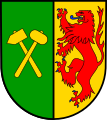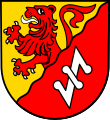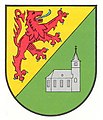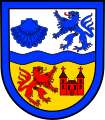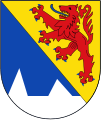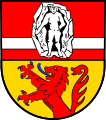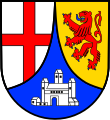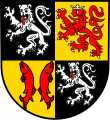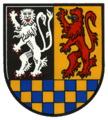Wild counts
|
Territory in the Holy Roman Empire |
|
|---|---|
| Wild county | |
| coat of arms | |
 
|
|
| map | |

|
|
| Territory of the Wild and Rhine Counts (blue) around 1400
|
|
| Arose from | Nahegau |
| Ruler / government | Count |
| Today's region / s |
DE-RP
|
| Reichskreis | Upper Rhine |
| Capitals / residences | Kyrburg , Schmidtburg , Dhaun , Grumbach |
| Dynasties |
Emichonen 1350/1409: Rheingrafen
|
| Incorporated into | 1113: Veldenz saved 1150: Raugrafen sep.
|
The aristocratic family of the Wildgraves (Latin: comites silvestres , actually: Forest Counts) came from a division of the Nahegau Counts in 1113.
history
The first wild count was Emicho VII (1103–1135), son of Count Emicho VI. (1076–1123) from Nahegau . Emicho VII was Count of Kyrburg , Schmidtburg and Baumberg and from 1129 Count of Flonheim . The line of the Counts of Veldenz had split off as early as 1113 . Around 1150 the Raugrafen split off. Part of the property was lost.
In 1154, Wildgraf Konrad I was sentenced to the dishonorable punishment of carrying dogs . The reason for the punishment was participation in an armed confrontation with Count Palatine Hermann von Stahleck and other nobles against the Archbishop of Mainz, Arnold von Selenhofen . Konrad was married to Mathilde von Bar , daughter of Rainald I. von Bar . Konrad's son was Gerhard I, who was married to Agnes von Wittelsbach (Agnes married Albert III von Everstein for the second time ). Konrad II succeeded Gerhard. Konrad was married to Gisela von Saarbrücken .
In 1258 there was a split into the Dhaun and Kyrburg lines , from which the Schmidtburg line separated in 1284 , but which died out in 1330. As a result of family disputes, the Schmidtburg fell to Kurtrier . The heirs of the Kyrburg and Dhaun lines tried to win back the Schmidtburg in three feuds in vain until 1342.
The Dhaun line died out before 1350 and finally the Kyrburg line in 1409. Heirs were the Rheingrafen , who from then on called themselves Wild- and Rheingrafen . These in turn came into the inheritance of the Counts of Obersalm in 1459/1475 and then called themselves Counts of Salm .
possession
The main focus of the property of the Wildgraves as direct successors of the Emichons was in the former Nahegau. The later territory was essentially composed of property, imperial fiefs , fiefs of the count palatine and bailiwick of the St. Maximin monastery . Important castles were: Kyrburg , Schmidtburg , Burg Dhaun and Burg Grumbach . The burial place of the house was the St. Johanniskirche zu Dhaun and from 1606 the church zu Herren-Sulzbach . Count Johann was able to obtain city rights for Grumbach in 1330.
Emicho VII originally owned Kyrburg, Schmidtburg, Baumburg and Flonheim . When his grandson Konrad became Abbot of St. Maximin, he still got Dhaun. Baumburg was transferred to the Raugrafen when they split off . Under Konrad II the Grumbach Castle was added, which he built. Also Dhronecken came under him to the Waldgraves. After the first division under Emich II, Kyrburg, Schmidtburg, Dhronecken and Flonheim fell to him, while his brother Gottfried I took over Dhaun and Grumbach. Emich's line was further subdivided in the following generation, so that his son Gottfried II. Kyrburg, Dhronecken and Flonheim belonged to Konrad III. became Wildgraf zu Schmidtburg, whose line died out again in the grandchildren's generation. Schmidtburg then fell to Gottfried II's grandson, but was drawn in again shortly afterwards as a settled fiefdom. He only owned Kyrburg and Flonheim, since Dhronecken had gone to his brother Otto. The Dhronecken line died out again in the same or the following generation and was drawn in again. When the wild counts united with the Rhine counts, first Dhaun and Grumbach, then Kyrburg and Flonheim as well, fell to them.
coat of arms
The wild counts line Dhaun had the following coat of arms: In gold a red, (mostly) blue crowned lion. The coat of arms of the Kyrburg line, on the other hand, was: In red, three (2: 1) upright, golden lions. Both still appear today in a number of current municipal coats of arms, e.g. B .:
Known family members
- Gerhard Wildgraf von Dhaun († 1259), as Gerhard I Archbishop of Mainz
- Konrad II. Wildgrave of Dhaun († 1279), 1258–1278 / 1279 as Konrad II. Bishop of Freising.
- Emicho Wildgraf von Kyrburg († 1311), 1283–1311 Bishop of Freising
- Friedrich Wildgraf von Kyrburg († after 1310), Upper German Provincial Master and Grand Prior of the Templar Order
- Conrad III. von Dhaun († 1434), 1419–1434 as Conrad III. Archbishop of Mainz
See also
literature
- Friedrich Toepfer: Supplements VIII. The Wildgrafen von Daun and XII. The wild counts on Kirburg . In: ders. (Ed.): Document book for the history of the Count and Baronial House of the Voegte von Hunolstein , Vol. I. Jacob Zeiser, Nuremberg 1866, pp. 317–320 ( Google Books ) and pp. 334–339 ( Google Books )
- Winfried Dotzauer: History of the Nahe-Hunsrück area from the beginnings to the French Revolution , Franz Steiner Verlag, Stuttgart 2001, ISBN 3515078789 ( online at Google Books )
- Gerhard Köbler : Historical lexicon of the German countries. The German territories and imperial immediate families from the Middle Ages to the present. 6th, completely revised edition. CH Beck, Munich 1999, ISBN 3-406-44333-8 .
Web links
- Bernhard Peter: The coats of arms of the Rhine and wild counts and later princes of Salm
- Genealogy of the Counts of Veldenz and the Wildgrafen
Individual evidence
- ^ Evangelical parish of St. Johannisberg
- ↑ "The Wild and Rheingrafschaft in Grumbach" at grumbach-pfalz.de ( Memento of the original from October 18, 2016 in the Internet Archive ) Info: The archive link has been inserted automatically and has not yet been checked. Please check the original and archive link according to the instructions and then remove this notice.
- ↑ "Die Wildgrafschaft" at grumbach-pfalz.de ( Memento of the original from October 18, 2016 in the Internet Archive ) Info: The archive link was inserted automatically and has not yet been checked. Please check the original and archive link according to the instructions and then remove this notice.






